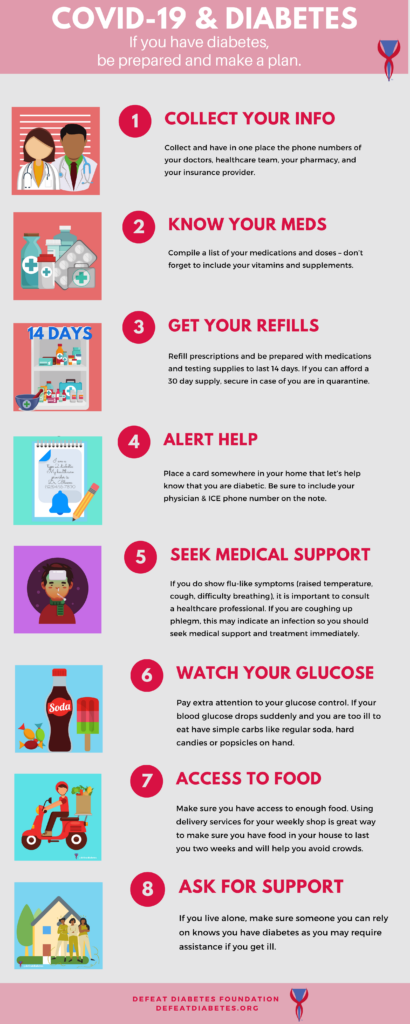The COVID-19 outbreak has been declared a global pandemic by the World Health Organization (WHO). In general, people with diabetes (type 1, type 2, or gestational) face greater risks of complications when dealing with viral infections like flu, and that is likely to be true with COVID-19.
Diabetes, and other chronic medical conditions, can make people more vulnerable to infections, leading to serious consequences. In addition, uncontrolled diabetes with hyperglycemia is known to impair immune function. Because patients with diabetes may also have many other comorbidities such as organ failure and cardiovascular disease, it is important for people living with diabetes to take precautions to avoid the virus if possible.
Here are some basic protective measures against the new coronavirus:
- Regular and sustained handwashing – whenever you use the restroom, eat, or use a public place – for at least 20 seconds or more. Try singing the chorus from Africa’s Toto or the Bee Gees’ Staying Alive, which are just about the right length.
- Sanitize frequently used technology, devices, and appliances regularly – your phone and laptop keyboard can be strong vectors for infection if ignored.
- Cover your nose and mouth when coughing or sneezing with a tissue or a flexed elbow, then throw the tissue in the trash.
- Avoid touching your eyes, mouth or nose when possible.
- Replace hugs and handshakes with an elbow bump.
- Minimize unnecessary travel or gathering in large public spaces if at all possible. Now is the time to consider working from home, postponing upcoming travel, or using delivery services,
- Stay home when you are sick.
If you have diabetes, be prepared and make a plan:
- Phone numbers of your doctors, healthcare team, your pharmacy, and your insurance provider.
- List of medications and doses – don’t forget to include your vitamins and supplements.
- Refill prescriptions and be prepared with medications and testing supplies to last 14 days (or up to 30 days, if not cost prohibitive) in case of worst-case scenarios (e.g. quarantine).
- Any infection is going to raise your glucose levels and increase your need for fluids, so make sure you can access a sufficient supply of water.
- If you do show flu-like symptoms (raised temperature, cough, difficulty breathing), it is important to consult a healthcare professional. If you are coughing up phlegm, this may indicate an infection so you should seek medical support and treatment immediately.
- Make sure you have access to enough food.
- Pay extra attention to your glucose control. Make sure you will be able to correct the situation if your blood glucose drops suddenly and you are too ill to eat. Have simple carbs like regular soda, honey, jam, Jell-O, hard candies or popsicles on hand.
- If you live alone, make sure someone you can rely on knows you have diabetes as you may require assistance if you get ill.
If you present with symptoms such as fever, cough, shortness of breath or wheezing, especially if you believe you may have been exposed to COVID-19 or live in or have recently traveled to an area with ongoing spread, call or see a healthcare professional immediately. Explain any symptoms, recent travel or possible exposure to COVID-19. Your healthcare professional will work with your state’s public health department and CDC to determine if you need to be tested for COVID-19.
For further information and regular updates on the COVID-19 outbreak, please visit the CDC or WHO websites.



